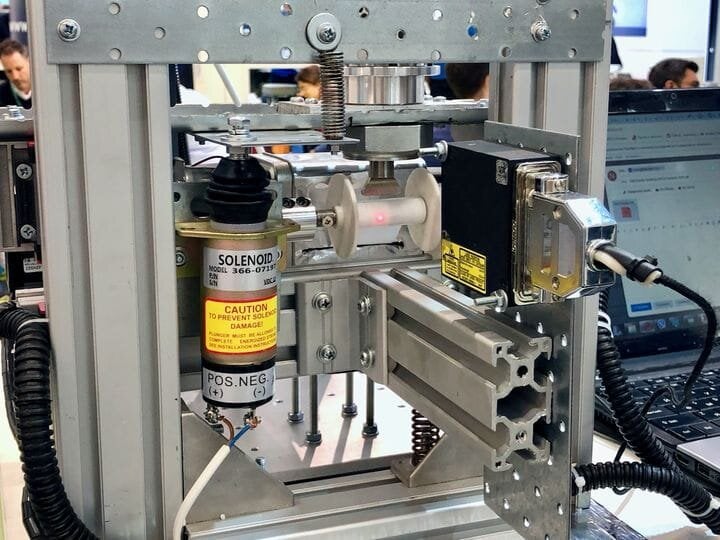![Prototype 3D printer using the Roll Powder Sintering (RPS) process by A1 [Source: Fabbaloo]](https://fabbaloo.com/wp-content/uploads/2020/05/rps-machine-1_img_5eb08cb9ebf68.jpg)
I recently encountered what must have be the most bizarre 3D printing process ever, Roll Powder Sintering, or “RPS”.
When you stroll around a large trade show like Formnext, you often see unusual equipment that is not directly related to 3D printing, such as touch-probe QA scanners, injection moulding gear or high-end mechanical components. That’s the impression I had when I first saw the device at the A1 booth; just another unrelated machine. It did not look at all like a 3D printer.
But I had a weird feeling about this device, so I stopped and had a closer look. It was a very curious device, as it included what appeared to be a paper tape wrapped around rollers inside the exposed machine. Printing a paper tape? This obviously could not be a 3D printer.
Or could it?
A1 Roll Powder Sintering Process
I approached the stand and asked the inhabitants what they were up to, but it turned out they were three Russian scientists, none of whom spoke English, making it challenging to understand what they were doing.
They were excited to receive a visitor and I was determined to figure out what they were doing, so after half an hour of hand waving, finger pointing and looks at a printed slide presentation, I finally realized the incredible process they had invented.
And it will blow your mind.
Here’s how it works, as I understand it:
-
A paper tape roll is in the machine (it’s actually a type of material similar to styrofoam that’s 99% air)
-
The tape is fed under a low-power laser
-
The laser selectively engraves tiny “dents” in the tape as it passes by according to a pattern
-
A powder dispenser puts fine particles into the laser dents
-
The particles are now held in correct positions by the dents in the tape and gravity
-
A roller system squishes the tape/powder to a precise thickness
-
The powder-laden tape travels under an ultrasonic emitter horn
-
The emitter is sufficiently powerful to instantly weld the particles together
-
The tape continues to wind around a collector axis, getting larger as more tape arrives
-
As the sintered material “comes around” on the collector roll, it is ultrasonically sintered to the next layer!
-
The process continues, essentially 3D printing an object in a single spiral layer of tape around the collector
-
When completed the 3D printed object is hidden inside the tape roll
-
The tape roll is removed and placed in a post processing container
-
A solvent (water) dissolves the tape and reveals a completed 3D print!
![The Roll Powder Sintering 3D printing process from A1 [Source: A1]](https://fabbaloo.com/wp-content/uploads/2020/05/rps-process_img_5eb08cba3afe5.jpg)
![The Roll Powder Sintering (RPS) 3D printing process uses an ultrasonic emitter to sinter particles [Source: Fabbaloo]](https://fabbaloo.com/wp-content/uploads/2020/05/image-asset_img_5eb08cba819af.jpg)
I have never seen any 3D printing process even close to this concept, RPS, as they call it. Apparently it can work with any thermoplastic, metal or ceramic powder, making the process extremely versatile.
![Roll Process Sintering (RPS) involves making dents in a paper tape [Source: Fabbaloo]](https://fabbaloo.com/wp-content/uploads/2020/05/image-asset_img_5eb08cbabd231.jpg)
RPS Slicing
Here is a cross-section 3D print of a turbine, where you can see the spiral layers:
![Spiral layer view of an object sliced for the 3D printer from A1 [Source: A1]](https://fabbaloo.com/wp-content/uploads/2020/05/rps-spiral_img_5eb08cbb0505e.jpg)
The only tricky aspect of RPS is that the slicing software must calculate the positioning of the spiral layer by accounting for the gradually increasing diameter of the collector roll and ensure the next layer always lines up.
Roll Powder Sintering Benefits
Post processing is straightforward, as you simply dunk your “roll” in some water. I should also point out that there is no support material required; the tape holds up any unsupported material during the 3D print.
![Decomposing a spiral slice for an object for the RPS 3D printer from A1 [Source: A1]](https://fabbaloo.com/wp-content/uploads/2020/05/rps-gcode_img_5eb08cbb47c7c.jpg)
RPS should also be very inexpensive to implement, as it requires no high power laser systems or atmospheric controls. Just some cheap foam tape, motors, basic laser and spools. And an ultrasonic emitter.
The process is also said to be highly scalable. You could, for example, embed multiple small objects inside the roll, and it’s not like each print must have a hole in the middle to account for the spool axis; prints are simply arranged around the axis.
RPS Print Speed
I was told RPS could theoretically 3D print 1.2 cubic meters of material per hour if scaled up! That’s 12 cubic meters of 3D print in a 10 hour work day! And indeed, A1 has visions of developing industrial sized versions of RPS 3D printers, as seen in this image:
![Concept for an industrial-sized RPS 3D printer from A1 [Source: A1]](https://fabbaloo.com/wp-content/uploads/2020/05/rps-industrial_img_5eb08cbb894c1.jpg)
What I saw at Formnext was merely a very early prototype of the device, but after understanding what it was, I became very excited. I suspect, however, that most attendees at Formnext simply walked by without having any notion of what the device really could do.
RPS 3D Printer Availability
![Company logo for “A1”, but it looks like “AI”. Roman numerals? [Source: Fabbaloo]](https://fabbaloo.com/wp-content/uploads/2020/05/rps-logo-1_img_5eb08cbbca575.jpg)
Why haven’t we heard of this previously? It’s because the company, “A1”, has only been in existence three months! They do not even have a website yet. Curiously, their logo is “AI”, but it is pronounced “A1”.
They hope to produce a working model of the system in about two months, and I’m quite interested to see this work. In the meantime they are working on the system’s software and also seeking investors.
I suspect they’ll quickly find some investors.

